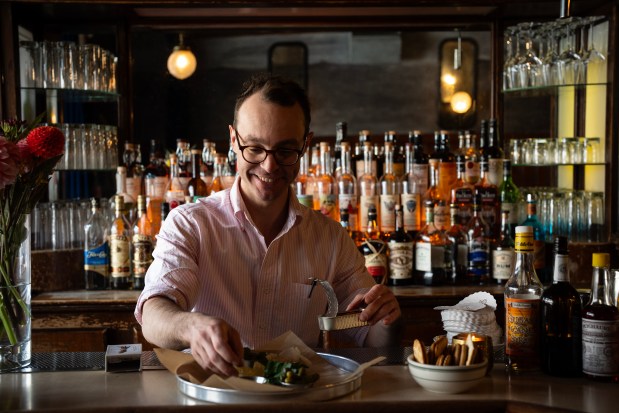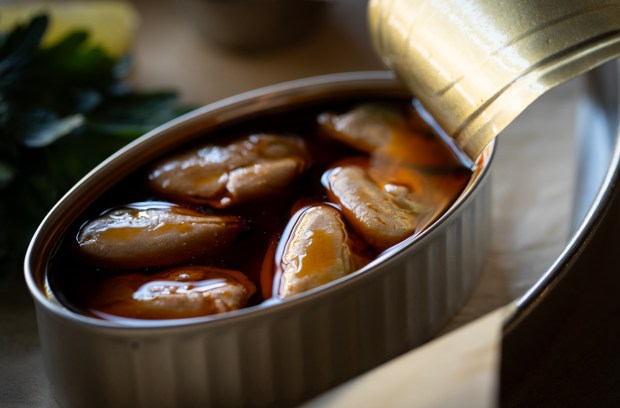Growing up in Southern California, my canned seafood consumption was limited to tuna packed in water, a scenario that played out in plenty of other American households. While a reliable sandwich filling when paired with mayonnaise and diced celery, a delicacy it was not.
Many years later, while working at a Chicago tapas restaurant, I met a Spaniard who, when traveling back home, would bring a small empty suitcase to be filled with the canned seafood she grew up on. I was confused — until, that it is, I tasted the conservas, the name given to preserved tinned seafood in Spain and Portugal, she brought back. I’ve been making up for lost time ever since.
These days I’m not the only Chicagoan — or American, for that matter — who has fallen in love with these imported and, more recently, domestic cans of seafood. Whether it’s tuna belly in olive oil, clams in brine, curry-infused mackerel or a number of other offerings, quality tinned seafood can now be found at local supermarkets, specialty shops, and on restaurant and bar menus.
From the day it opened in November 2015, Queen Mary Tavern has been serving conservas, says general manager Dan Smith, inspired by their travels to Spain and France, coupled with the limits of their small galley kitchen at the Wicker Park bar.
In those early days, however, guests were often perplexed and couldn’t understand why anyone would pay $15 or more for a can of fish, Smith says. To help change their minds, the staff would compare it to charcuterie. “We would tell guests that conservas are a way of preserving seafood, while at the same time transforming it, using heritage techniques and exceptional ingredients, creating a delicacy that’s comparable to the finest salumi or rillettes.”
Initially, their efforts didn’t have much of an impact. But two to three years ago, sales have grown dramatically. “Our guests no longer seem to be mystified by the very concept of fine tinned fish,” Smith says. “On the contrary, they come in knowing that conservas are one of our specialties and they have favorites they come back for.”
Currently, Queen Mary features seven conservas — including clams in seawater, spoked sea sprat with heather and chamomile, and squid in ink — that are paired with crackers, lemon wedges, Maldon salt, olives and pickles.
At Agora Market, formerly Fresh Market Place, it’s a similar situation. “It’s grown tremendously in the past couple of years, says manager Niko Hareas of the tinned seafood the market offers. He estimates they currently have 50 varieties of conservas from 20 brands.
Hareas credits travel, eye-catching packaging, restaurants and social media as driving the growth. “A lot of these brands have very cute packaging and that’s very nice for Instagram and TikTok,” he says. “A lot of companies are investing in that and getting the attention for it.”
COVID-19 and the desire for gourmet shelf-stable products also played a role. “We are a small store, but if we could give more real estate to it, we would,” he says.
Webster’s Wine Bar chef McKenna Winterholler has seen an overall increase in diners being more adventurous when it comes to food, with tinned seafood riding that wave. “With the rise of internet information, people can do their own research and see that most conservas have a deep history, the quality is unsurpassed and they can be eaten immediately.”
At the Logan Square wine bar, which celebrates its 30th anniversary this year, Winterholler includes language on the menu explaining the care taken to create the conservas they offer, which include sardines in a light tomato sauce, mackerel in curry and seabass packed in pesto. She serves them simply with crostini, olives, mustard and lemon.
“When you take a step back and take a larger view of things, you have to ask, what were we so afraid of?” says Bisous’ Peter Vestinos of tinned seafood in the U.S. “This is a safe and reliable technology that has been around for almost 200 years and allows us to have freshly packed seafood with all its flavors and nutrients in a shelf-stable form.”
At Bisous, the snacks menu’s tinned smoked rainbow trout and smoked Willapa Bay oysters — served with Kettle chips, tabasco and lemon — allow the West Loop cocktail lounge to offer premium products with very little effort. “Serving food and running a kitchen have become increasingly a losing game for most bars because of the high costs of food, labor and waste,” says Vestinos.
Daisies’ Joe Frillman has been passionate about conservas for some time. That enthusiasm grew when a friend began importing conversas directly from Spain and Portugal in 2017 with his wholesale company Preserved States. When the company moved to Seattle, Frillman purchased all the inventory to distribute in Chicago as a side hustle, a decision that proved fortuitous during the pandemic.
On the Logan Square restaurant’s happy hour menu, you’ll find 11 different conservas, ranging from El Capricho’s Cantabrian anchovies and Conservas de Cambados’ octopus in Galician sauce to scallops in brine from Real Conserva.
“Once you get diners to understand that some of the seafood available in the Midwest is better in cans because we’re not on a coast, they understand it’s not a far stretch to go from canned tuna to canned sturgeon and hake loin,” Frillman says.
Back at Queen Mary, Smith has noticed a subtle shift in diners’ tastes in conservas. While their bestsellers are still the more familiar and milder-tasting fish or those packed in a sauce, diners are becoming a bit more adventurous. “I wouldn’t be surprised if, as our guests gain familiarity with tinned fish, they come to value the pure flavor of the fish more, and also start to seek out more obscure offerings,” he says.
Like with many things in life, however, not all tinned seafood is created equal.
As a born and bred Spaniard, that’s something Marcos Campos, executive chef at Bonhomme Hospitality (Beatnik, GoodFunk, Mama Delia), knows firsthand. “I look for a tinned seafood company that respects the quality and seasonality of the ingredients,” he says. “Some conservas are made with cheap and frozen ingredients that affect the final result.”
Some of Campos’ favorite brands are from Spain’s Galicia, a region treasured for its high-quality conservas. La Brújula, Ramon Peña, Los Peperetes, Real Conservera and Conservas de Cambados are all brands he recommends.
Webster’s Winterholler appreciates conservas that are unique and go beyond olive oil, including ones from Portugal’s Jose Gourmet and Alalunga from Spain. While not on her menu, she also recommends conservas from Patagonia Provisions, a division of the outdoor clothing company, for their flavor and environmentally friendly mission. “That’s also the plus of tinned fish in general is there’s a large focus on sustainability,” she says.
Agora’s Hareas cites U.S. brand Fishwife, Canada’s Scout and Spain’s Siesta as ones he recommends, with extra points for clever packaging, which helps attract a younger audience.
Smith is a fan of “plain conservas” that are packed in brine or olive oil as well as those in richly flavorful sauces, both of which are featured at Queen Mary. He also recommends exploring tinned seafood from other countries. “Polish and Ukrainian markets in Chicago often have an extensive selection of imported preserved seafood that is its own wide world of options that I have recently begun to explore.”

While tinned seafood is great simply eaten directly out of the can, home cooks don’t have to stop there.
Frillman likes to add conservas to salad, using the uber-flavorful olive oil it’s packed in to create a vinaigrette dressing. Pastas are another terrific vehicle for conservas. Tinned scallops in tomato sauce, for example, can be used both as the sauce and indulgent ingredient. Frillman suggests adding the chopped scallops at the end as they are fully cooked.
To get a savory boost as well as some protein, he endorses adding tinned seafood to a vegetable-forward dish. And it’s not just food that can benefit from sidling up to a conserva. Add some brine from tinned clams to your next Bloody Mary for additional umami.
Winterholler is also a fan of the pasta-and-conserva combo. She recommends using tinned mussels as a way to avoid having to take them out of their shells. Risotto is another conserva-friendly vehicle. And whatever you do, don’t throw away the leftover oil, she says. Rather keep it refrigerated in a glass jar for up to six months and use it as a spread on toast or to cook eggs or a stew.
To build a tasty quick ceviche-style dish, Campos recommends adding clams, berberechos (cockles) or navajas (razor clams) to diced red onion and cilantro, using the natural seawater liquid along with lime juice to make a leche de tigre sauce.
Not quite ready to embrace tinned seafood?
Mussels and other shellfish are a good gateway conserva, Campos says. “The flavors are more delicate,” he says, with a squeeze of lemon adding acidity and freshness.
“My suggestion across the board when trying to expand your palate is start with something you like,” Winterholler says. At your next dinner party alongside a more traditional charcuterie and cheese board, she recommends adding a tinned fish section. “It’s a great way to expose other people too.” Looking for board-building tips? Check out Seattle-based chef Ali Hooke’s TikTok, who periodically offers #tinfishdatenight posts.
Lisa Shames is a freelance writer.




